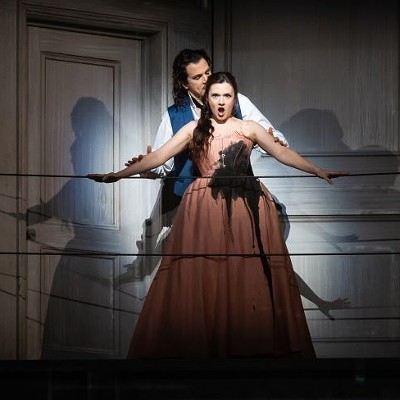This is a two-parter, the parts made separately but reconceived as one for the commission. Worry Will Vanish is two videos of ten minutes each; Pixel Forest, created in collaboration with lighting designer Kaori Kuwabara, is made up of thousands (Could it be 3,000? That figure was mentioned.) of LED lights hanging from the gallery ceiling, constantly changing through a 20-minute cycle. And there is specially commissioned music by Anders Guggisberg. “Together, the two installations — conceived independently — achieve a new synergy as they synchronize into a greater whole.” I quote the MFAH website since the museum knows better than I what it’s talking about.
Getting a work like this in place is a colossal job, the time, effort and money breathtaking. Rist and her team from Switzerland were in Houston for three weeks working with the MFAH group of curators and technicians, just getting it all up and synchronized by opening day. That’s after the years of planning, conceiving and fabricating. Rist said that talk of an MFAH commission started ten years ago, at the time of her one-artist show at the Contemporary Arts Museum Houston. So I realize that this is indeed a very big deal.

Pipilotti Rist, Worry Will Vanish Dissolution, 2014, two-channel video and sound installation, ed. 3/3, the Museum of Fine Arts, Houston, Museum purchase funded by the Caroline Wiess Law Accessions Endowment Fund.
© Pipilotti Rist / Courtesy of the artist; Luhring Augustine, New York; and Hauser & Wirth / Photo: Alex Delfanne
But I’m trying to approach this and similar works by invoking a new mantra: Just try to have fun; just try to have fun. Though that may seem a little lowbrow, and utterly disrespectful to the ghosts of Rubens, Rembrandt and Jackson Pollock hovering in the Beck Building galleries across the street, I recommend that most of my readers approach it the same way.
There will, of course, be those among you who know enough about “light-based and immersive art,” to quote the museum’s promo on the show again, that you can bring your brains to it too, and perhaps your experience will be richer for it. But not even the artist would necessarily say that’s the best strategy. At the preview I attended, she told us that the work came from “closing the eyes, daydreaming and trying to make a journey through the limbs.”
Since it’s largely a light and video adventure, the “closing the eyes” part might not really be the best strategy: Maybe that was a concept that didn’t translate smoothly. But as with much art of any kind, the ditching-the-brain thing can be helpful, at least at the start.
One very nice aspect of this show, as compared to some of the MFAH summer things of years past, is that there’s lots of room for lots of people. You shouldn’t be facing long lines, and I think you can stay as long as you like. Also, you can walk freely among the light strings without being dogged by guards, or you can lounge on beanbags watching videos (or sit on stools, for those whose knees don’t mix with beanbags anymore) till videoed out. No long waits and short stays as with “Kusama”; no booties as with “Turrell.”
Pipilotti Rist, Pixel Forest Transformer, 2016, LED installation with media player, the Museum of Fine Arts, Houston, Museum purchase funded by the Caroline Wiess Law Accessions Endowment Fund.
© Pipilotti Rist / Courtesy of the artist; Luhring Augustine, New York; and Hauser & Wirth / Photo: Mancia Bodner, courtesy Kunsthaus Zürich
In light of my new mantra, I’ve tried hard on more than one visit to become a convert to immersion art. I met the artist, who was charming and enthusiastic, so I’d hate to let her down. It’s always a dicey proposition in reviewing, bringing the personal into it that way. And it would be nice to prove that even now I’m not too old to be “with it” or have fun. Still, I’m not sure what I was supposed to feel, but whatever it was, I have the feeling I didn’t feel it.
But as I sat on one of the stools, watching the videos for the fourth, or maybe tenth time — fascinated in particular by what must be someone’s colonoscopy screening, and pristine it is too — it did hit me how dull by contrast much museum installation can be: the same paintings in the same places — ching, ching, ching — sometimes for years. When you think about it, any gallery experience is an art immersion, though we seldom think of it that way.
After my last visit behind the curtain (you’ll know what that means when you go) to the buzzing, colorful, music-light-people-filled world of Pixel Forest, I went for a tour of the almost empty, hallowed halls of Rubens, Rembrandt and Pollock across the street, and longed for a little more pizzazz with my paint-on-canvas-on-walls. Could it be that Rist is actually nudging me toward the new century?
Pipilotti Rist, Pixel Forest Transformer, 2016, LED installation with media player, the Museum of Fine Arts, Houston, Museum purchase funded by the Caroline Wiess Law Accessions Endowment Fund.
© Pipilotti Rist / Courtesy of the artist; Luhring Augustine, New York; and Hauser & Wirth / Photo: Mancia Bodner, courtesy Kunsthaus Zürich
But back to Pixel Forest and Worry Will Vanish: On my second visit, after the lights and music and video had cycled through their synchronized loop a couple of times, the sultry vocals of Peggy Lee came into my mind, singing her sardonic masterpiece (you can hear it for yourself on YouTube):
Is that all there is
If that’s all there is, my friends
Then let’s keep dancing
Let’s break out the booze and have a ball
If that’s all there is…
And I longed for the flashing-disco-ball immersions of my youth — when, on a lucky night, the lights, music, dancing might not be all. Spoiler alert: At Pixel Forest there are lights and music, but you may find the dancing a little dull some days, and there is no booze. That’s all.
“Pipilotti Rist: Pixel Forest and Worry Will Vanish”
Through September 17. Museum of Fine Arts, Houston, 1001 Bissonnet, 713-639-7300, mfah.org.






